Agricultural Sciences Paper 1 Questions - Grade 12 September 2021 Preparatory Exams
Share via Whatsapp Join our WhatsApp Group Join our Telegram GroupINSTRUCTIONS AND INFORMATION
- This question paper consists of TWO sections, namely SECTION A and SECTION B.
- Answer ALL the questions in the ANSWER BOOK.
- Start EACH question on a NEW page.
- Number the answers correctly according to the numbering system used in this question paper.
- You may use a non-programmable calculator.
- Show ALL calculations, including units and formulae, where applicable.
- Write neatly and legibly.
QUESTIONS
SECTION A QUESTION 1
1.1 Various options are provided as possible answers to the following questions. Choose the answer and write only the letter (A–D) next to the question numbers (1.1.1 to 1.1.10) in the ANSWER BOOK, for example 1.1.11 B.
1.1.1 The process whereby food is pushed through the alimentary canal by the contraction and relaxation of the muscles is known as … .
- rumination.
- digestion.
- peristalsis.
- absorption.
1.1.2 The nutrient that provides immunity to protect an animal’s body against germs and antigens.
- Carbohydrates
- Proteins
- Lipids
- Fats
1.1.3 The palatability and digestibility of a low-grade roughage for a ruminant can be improved by …
- mixing roughage with molasses.
- supplementing the ration with non-protein nitrogen substances.
- supplementing it with teff hay.
- adding small quantities of urea and biuret.
Choose the CORRECT combination:
- (i), (iii) and (iv)
- (ii), (iii) and (iv)
- (i), (ii) and (iv)
- (i), (ii) and (iii)
1.1.4 A shortage of phosphorus in the bodies of farm animals leads to a condition known as …
- goiter.
- anaemia.
- parakeratosis.
- pica.
1.1.5 The method of handling farm animals applicable to sheep:
- Catching the animal as high as possible on a hind leg
- Using a neck clamp to bring animal to a standstill.
- Moving the animal from behind.
- Throwing stones to direct animals.
1.1.6 The following is NOT a characteristic of an intensive production enterprise:
- A relatively small piece of land is used.
- Large sum of capital is invested.
- Lots of labour is utilised.
- Enterprise covers a vast area of land.
Choose the correct combination:
- (i), (iii), and (iv)
- (ii), (iii) and (iv)
- (i), (ii) and (iv)
- (i), (ii) and (iii)
1.1.7 The following statement is TRUE about enzootic diseases.
- Transmitted from humans to animals.
- Affects specific animals in a particular region.
- Not regarded as contagious diseases.
- Result from disorders that disturb metabolic processes.
1.1.8 The statements below apply to the life cycle of a single-host tick.
- Eggs hatch into larvae.
- Nymph develops into an adult.
- Larvae and nymph live on an intermediate host.
- Larvae develops into a nymph
Choose the CORRECT combination:
- (i), (iii) and (iv)
- (ii), (iii) and (iv)
- (i), (ii) and (iv)
- (i), (ii) and (iii)
1.1.9 A characteristic observed during the microscopic evaluation of semen:
- Volume
- Colour
- Density
- Abnormalities
1.1.10 … refers to the attachment of the embryo to the endometrium of a sow.
- Copulation
- Synchronisation
- Implantation
- Retention (10 x 2) (20)
1.2 Indicate whether each of the descriptions in COLUMN B applies to A ONLY, B ONLY, BOTH A AND B or NONE of the items in COLUMN A. Write A only, B only, both A and B or none, next to the question numbers (1.2.1 to 1.2.5) in the ANSWER BOOK, for example 1.2.6 B only.
COLUMN A | COLUMN B | ||
1.2.1 | A: | Cafeteria style | Method of supplementing calcium borogluconate in dairy cows with milk fever |
B: | Injection | ||
1.2.2 | A: | Lupins | A protein-rich concentrates from plant origin which are used to balance roughage |
B: | Oilcake meals | ||
1.2.3 | A: | Advanced technology | A factor to increase animal production under extensive farming |
B: | Provision of ventilators | ||
1.2.4 | A: | Drenching | The method of administering medication to animals on the skin |
B: | Topical | ||
1.2.5 | A | Inexperience | The factor that causes infertility in young bulls |
B: | Nutrition | ||
(5 x 2) (10)
1.3 Give ONE word/term for each of the following descriptions. Write only the word/term next to the question numbers (1.3.1 to 1.3.5) in the ANSWER BOOK.
1.3.1 The measure of the quality of a protein in a feed
1.3.2 The service rendered by the state where animals are kept in isolation for a particular period while being tested for diseases
1.3.3 The phenomenon where the testis remain in the abdominal cavity
1.3.4 The term used to describe bulls that is interested in cows but lack the ability to serve it
1.3.5 A sterile female calf born when the twins of the opposite sex develop in the uterus of a cow (5 x 2) (10)
1.4 Change the UNDERLINED WORD(S) in each of the following statements to make it TRUE. Write only the answer next to the question numbers (1.4.1 to 1.4.5) in the ANSWER BOOK.
1.4.1 The enzyme in the small intestine of an animal that splits the fat molecule is called amylase.
1.4.2 Castration is the process of removing young suckling animals permanently from their mothers.
1.4.3 A dilutant is a yellowish, salty creamy liquid secreted from the mammary glands at parturition and provide antibodies.
1.4.4 Spermatozoon is the end product of the process of oogenesis.
1.4.5 Hermaphrodite is a cow that needs to mate three or more times before it conceives. (5 x 1) (5)
TOTAL SECTION A: 45
SECTION B
QUESTION 2: ANIMAL NUTRITION
Start this question on a NEW page.
2.1 The diagram below indicates the teeth of farm animals.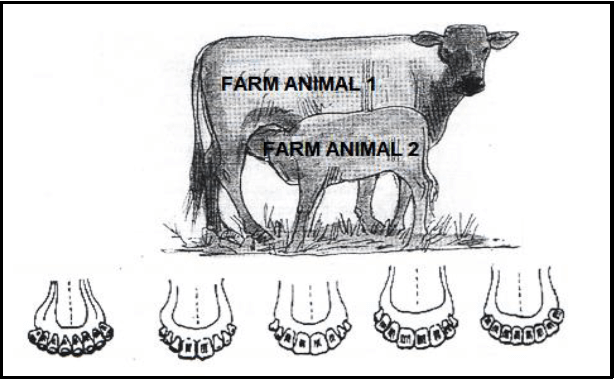
2.1.1 Indicate whether the teeth in the diagram above represent the lower or upper jaws. (1)
2.1.2 Name the type of digestion done by the teeth in the diagram above. (1)
2.1.3 Explain the importance of teeth together with saliva in FARM ANIMAL 1. (2)
2.1.4 Name the part of a fowl that performs the same function done by teeth in the diagram above. (1)
2.1.5 Explain the path of milk in FARM ANIMAL 2. (2)
2.2 The structure below shows a part of the alimentary canal in farm animals.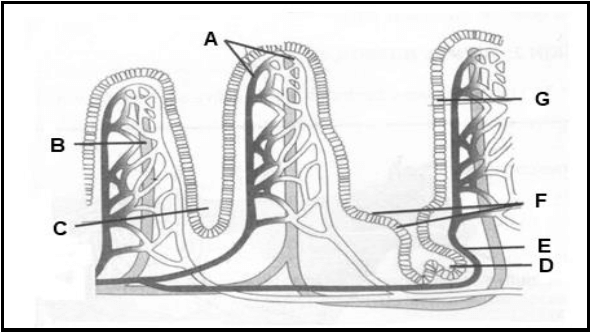
2.2.1 Name the part of the alimentary canal where the structure illustrated above is found. (1)
2.2.2 Indicate the nutrients absorbed in parts labelled A and B. (2)
2.2.3 Mention the process that follows after absorption of nutrients stated in QUESTION 2.2.2. (1)
2.2.4 Name ONE adaptation feature of the structure above that helps it to perform its function. (1)
2.3 The graph below shows different feeds with different feed components. (Digestible carbohydrates, fats and protein)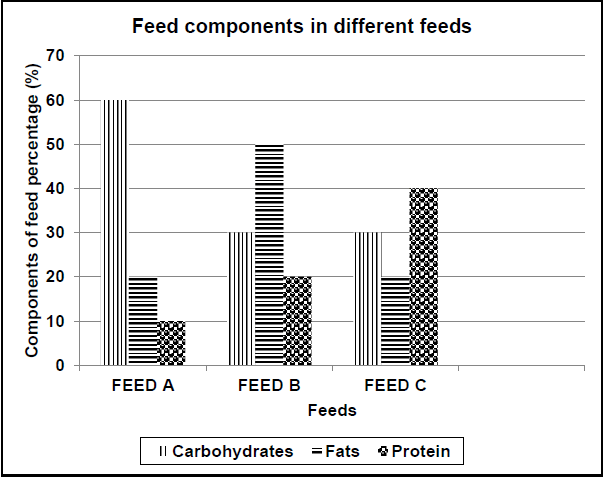
2.3.1 Identify the feed from the graph above that would be most suitable for each of the following situations:
- Young growing animals
- Fattening of old ewes
- Provision of insulation against temperature changes (3)
2.3.2 Suppose feed B has 85% TDN; then calculate the nutritive ratio of this feed. (3)
2.3.3 Determine the ratio of feed A and feed C that can be mixed to get a feed with 18% DP. (4)
2.4 Chemical substances are used in feedlots for beef production to increase the growth rate. Name the most applicable substance that can be administered to animals in each of the following cases:
- A substance administered to cattle in a feedlot to calm them down
- A substance administered to increase the metabolic rate of farm animals (2)
2.5 The table below shows the production of lucerne in kg DM/Ha for a period of one year on a 42-hectare farm.
MONTHS OF THE YEAR | QUANTITY OF LUCERNE PRODUCED (KG DM/HA) |
January | 1 200 |
February | 800 |
March | 200 |
April | 200 |
May | 100 |
June | 50 |
July | 50 |
August | 200 |
September | 300 |
October | 400 |
November | 600 |
December | 1 200 |
2.5.1 Use the information in the table above to draw a bar graph. (6)
2.5.2 If the farmer has 35 lactating cows and each need 5 kg of lucerne a day for optimum production. Calculate the total amount of lucerne the cows will need in June. (Show ALL calculations.) (2)
2.5.3 Determine whether there will be enough lucerne for these lactating cows in June. (Show ALL calculations.) (3)
[35]
QUESTION 3: ANIMAL PRODUCTION, PROTECTION AND CONTROL
Start this question on a NEW page.
3.1
| A farmer owning 40 hectares of land in a sourveld area planted kikuyu to finish off steers on a pasture. About 20 hectares allocated for grazing was divided into four camps using thorny shrubs to fence off each camp. Five animals were allowed in one camp on a rotational basis. The farmer believed in breeding animals adapted to the environment so that they utilise grazing as much as possible instead of artificially changing the environment to suit animals. |
3.1.1 Identify the animal production system used by the farmer in the scenario above. (1)
3.1.2 Give TWO reasons for the answer in QUESTION 3.1.1. (2)
3.1.3 Name the farming system that can be linked with the production system in QUESTION 3.1.1. (1)
3.1.4 Identify the measures in the scenario above, to increase animal production under the following:
- Nutrition
- Reproduction
- General enterprise management (3)
3.2 The pictures below show facilities/equipment used in an animal producton system.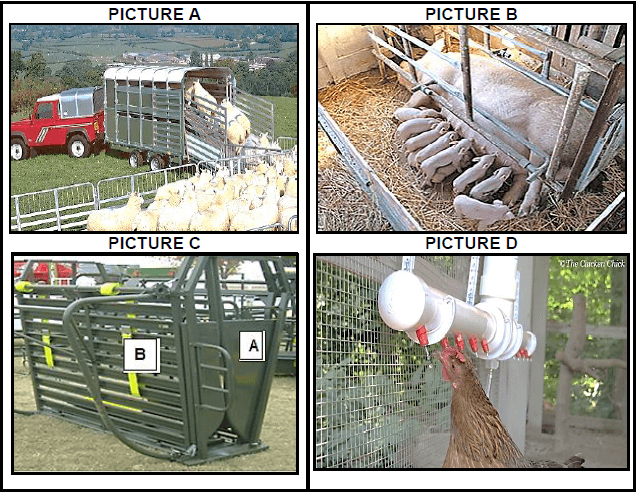
3.2.1 Identify the facility/equipment in PICTURE B and PICTURE D. (2)
3.2.2 State the purpose of using the facility labelled A in PICTURE C. (1)
3.2.3 Indicate TWO design features of the facility labelled B in PICTURE C. (2)
3.2.4 A permit is one of the requirements needed when moving animals using the facility in PICTURE A. Indicate the information that must be included in the permit. (2)
3.3 Pigs are sensitive animals that are frightened easily and can display certain behavioural patterns when in distress.
3.3.1 Name TWO signs of distress in pigs. (2)
3.3.2 Incorrect handling of animals during transportation can have an effect on animals and their products. Justify this statement with TWO effects. (2)
3.4 It is important that animals must be tested on a regular basis to detect diseases in its early stages.
3.4.1 Give TWO signs that show that an animal is sick. (2)
3.4.2 Indicate TWO methods a farmer can use to test animal health. (2)
3.5 The illustration below shows the life cycle of the anthrax.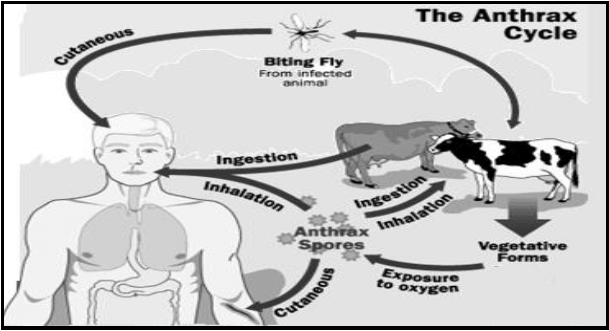
3.5.1 Indicate the pathogen that causes the disease illustrated above. (1)
3.5.2 Identify from the illustration TWO ways in which the disease can be transmitted. (2)
3.5.3 The disease above is zoonotic. Justify this statement by referring to the illustration. (2)
3.5.4 Name TWO steps the farmer can take to prevent a further spread of the disease in the above illustration when the outbreak has occurred. (2)
3.6 Ticks are the most transmitters of diseases in farm animals. They create an opening on the skin of an animal and allow pathogens to penetrate and cause diseases.
3.6.1 Classify the parasite in the scenario above. (1)
3.6.2 Give a reason for the answer in QUESTION 3.6.1. (1)
3.6.3 Ticks are classified according to their life cycle. Name the tick that belongs to the following classes:
- Three-host tick
- One-host tick (2)
3.6.4 Indicate TWO economic impacts of ticks for the farmer. (2)
[35]
QUESTION 4: ANIMAL REPRODUCTION
Start this question on a NEW page.
4.1 The diagrams below show the organs in the reproductive system of a bull and a cow.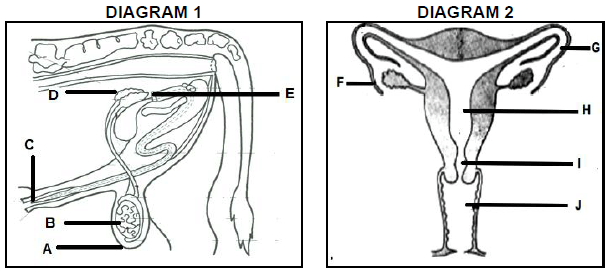
4.1.1 Identify the letter from the diagrams above where each of the following occurs.
- Spermatogenesis (2)
- Deposition of semen during artificial insemination (1)
- Sperm cell fuses with the egg cell (1)
- Copulating organ Diagram A and Diagram B (1)
4.1.2 Name the inner and the middle membranes surrounding the fetus at the part labelled H. (2)
4.1.3 Parts labelled A and F play an important role in the reproductive systems above. Justify this statement by explaining the role of these parts. (2)
4.2 The flow chart below shows the reproductive processes in cows.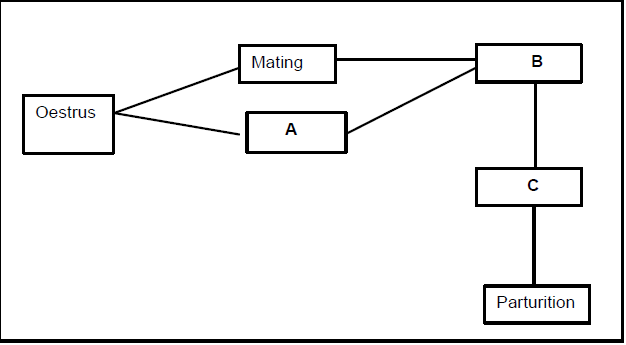
4.2.1 Identify the processes labelled B and C. (2)
4.2.2 The process labelled C is characterised by three stages. Indicate the first and the last stage. (2)
4.2.3 The process labelled A can be induced to a cow. Name that process. (1)
4.2.4 State TWO economic benefits of the process mentioned in QUESTION 4.2.3 for the farmer. (2)
4.2.5 Indicate TWO factors that may cause the retention of the placenta during parturition. (2)
4.3 The diagram below illustrates the reproductive process in farm animals.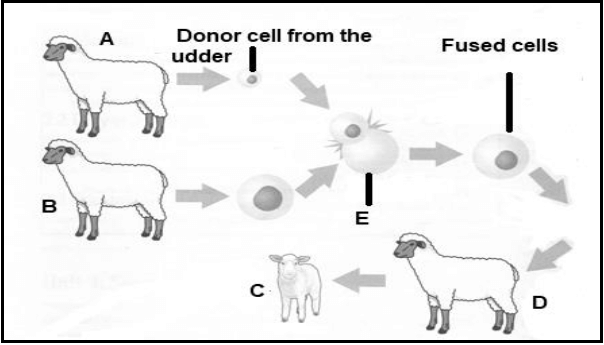
4.3.1 Identify the reproductive process illustrated above. (1)
4.3.2 Refer to the illustration above to explain a reason for your answer in QUESTION 4.3.1. (2)
4.3.3 Name the process that has occurred in the cell labelled E. (1)
4.3.4 Indicate the letter of the sheep that corresponds with the information below:
- Acts as a surrogate
- Genetically identical to sheep C
- Donated an egg cell (3)
4.3.5 State TWO aims of the reproductive process illustrated in the diagram above. (2)
4.4 Below is the diagram showing the structure of an udder and the pie chart.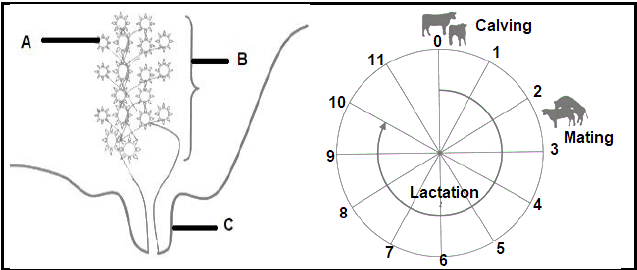
4.4.1 Identify parts labelled A, B and C. (3)
4.4.2 Indicate the role of part A during lactation. (1)
4.4.3 Name the stage in the lactation cycle between month 10 and the next calving. (1)
4.4.4 Explain the importance of the stage mentioned in QUESTION 4.4.3 for the lactating cow. (2)
4.4.5 Identify from the lactation cycle the number of months lactation period last. (1)
[35]
TOTAL SECTION B: 105
GRAND TOTAL: 150